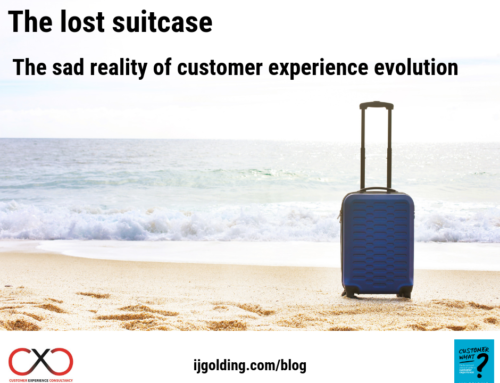
I have sometimes been accused of intentionally looking for the bad things that organisations do to customers. Whilst it is true to say that I often describe experiences that are a long way from meeting customer expectation, I never actively seek out the negative. If I am guilty of anything, it is of reporting the truth – the truth as I see it and the truth that I personally experience. Much of what I write about is extremely positive, yet I and others continue to encounter negative experiences too often.
Negative customer experiences are the effect of a plethora of causes. Broken processes; ineffective behaviour; weak leadership; inappropriate organisational culture; poorly designed customer journeys; are all amongst the most commonly occurring. However some negative experiences occur for one simple reason – someone made a mistake.
Mistakes happen – we have all at sometime made one. I guarantee that every one of you reading this blog post have one mammoth mistake story that you can recount around the dinner table. At the weekend we had lunch with friends. Mrs C (I will obviously not reveal who Mrs C is) once used to work in the HR function of a large organisation. She accidentally shared with a group of colleagues the plan to dismiss a number of underperforming people – she realised just a little too late that the people she was sharing the plan with WERE the underperforming people themselves! She was mortified – as were the poor people affected. Mrs C had made a mistake. Mrs C never made the same mistake again!
People will never be immune from making mistakes, nor will the organisations they work for. However robust your business processes; however much you try to ‘mistake proof’ the things your business does; mistakes will happen. In the world of Customer Experience, they absolute key is for an organisation to know how to deal with mistakes – and to deal with them so well, that they are still able to maintain and sustain their relationship with valuable customers.
Like every one of you, I have made my fair share of mistakes. Sometimes my mistakes are as simple as using the wrong name in an email – only yesterday I sent an email to a lady called Susan – I had ‘copied and pasted’ an email that I had already sent to a man called Greg. You guessed it….I forgot to change the name I was addressing the email to from Greg to Susan! It happens! Whilst it is incredibly annoying for the mistake maker, it is not very nice for the recipient either. That is why I believe that we should all consider having a method for dealing with mistakes. The method that I use can be summarised as the 3 A’s – Acknowledge, Apologise and Address. In the case of my email to Susan/Greg, I was told of my mistake by another colleague. Having muttered an expletive to myself, I immediately sent Susan an email acknowledging the mistake. In my email I apologised and explained what had happened. Fortunately for me, Susan was very forgiving as a result. I like to think it was my act of Acknowledging, Apologising and Addressing that enable her to forgive so easily.
A few weeks ago, I was party to a far graver mistake. This was a mistake that made me feel physically sick – we have all been there. I would like to share this story with you as a way of explaining my 3 A’s principle. Custerian were to hold our first Customer Experience seminar in London. Having decided upon a date, we agreed our marketing strategy. In addition to publicising the event across all of our social media networks, we decided that we would send an email to as many of our contacts as possible.
Having created the wording of the email and inserted a web link to the registration page for the event, the email addresses were inserted into the email. This is where the rather serious error occurred. Instead of ‘blind copying’ the email to all recipients, the email was mistakenly sent to well over a thousand people with all email addresses clearly visible. I was not immediately aware of the error. It was only when I received an email from a contact who can only be described as ‘livid’, that I realised a mistake had been made. I was horrified. My heart rate climbed very quickly – I started to sweat profusely. Within thirty minutes of the email being sent, I received a dozen emails back from disgruntled recipients. Having taken stock, I needed to act – and fast.

My first act was to create an email response to everyone who had received the original. In my response (which was ‘blind copied’ to all!!) my opening words were those of an acknowledgement of the mistake. I think it is imperative when a mistake has been made to be open and honest about it – do not try to defend your actions. Do not try to blame someone else. A mistake had been made and it was important I acknowledged it.

My second act was to apologise. Whether people had noticed the mistake or not, it was vital that I openly apologised for making an error. What had happened was unacceptable and I needed to show genuine empathy for those who felt negatively affected by my actions. Some told me not to worry – others said that they were not even clear what the issue was. However I knew that some people were really not happy, and so it was critical to ensure they could see my genuine apology.

My third action was to address the issue. The mistake was made because I failed to ensure that the process we followed was robust. Prior to the email being sent out, I had failed to check that everything was all ship-shape. I will never make the same mistake again. I also needed to reassure all recipients of the rogue email that not only would I ensure it would not happen again, but that they also had the option to go a step further. I made the offer to everyone who received the email to be removed from our contact lists – to give them the assurance that they could not receive another contact from me if that is what they wanted.
My actions led to a significant minority of people asking to be ‘removed from my contact lists’ – that is regrettable. The significant majority however were very quick to get in touch with me. They did not get in touch to berate me – quite the contrary. Dozens of people in my networks got in touch to thank me for my actions. They emailed me to say how I needn’t worry. Many wanted to make sure that they were never removed from my contact lists. You may think that I being a little over the top here, but their emails made me a little emotional.
I believe that my principle of Acknowledging, Apologising and Addressing had made my network even stronger. My ‘customers’ became even more connected with me as a result. The small number of people who chose not to ‘forgive’ the mistake may not have been the ideal connections for me in the end. I will undoubtedly make mistakes again in the future. If that happens, I will set my 3 A’s principle in motion once more. As people we know that others make mistakes and we appreciate it when they admit it. We feel better when we receive an apology for the mistakes that are made and reassured when the mistake maker does something to address the mistake.
Too many businesses do not apply these principles when conducting business. They defend, divert and refute anything that can be perceived as a weakness. All this does is to serve to alienate customers. I hope that businesses can learn something from the 3 A’s principle and start to see the benefits of dealing with mistakes in an open, honest, genuine and empathetic way.






Leave A Comment